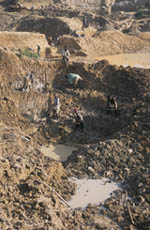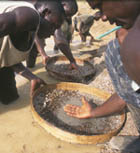|
With the Blood Diamonds are For Never campaign, One
Sky and campaign participants worked hard to end the trade
in conflict diamonds by strengthening the Kimberley Process.
Ensuring the success of the Kimberley Process is one step
- and an important one. If effectively implemented, the Kimberley
Process will ensure that diamonds cannot be used to finance
war and atrocities. NGOs and the public need to watchdog its
implementation and encourage countries to sign up for voluntary
independent monitoring. But the question remains…
Is your
Diamond considered clean?
In November 2003 One Sky, Friends of the Earth Sierra Leone
(FOESL) and the Conservation Society of Sierra Leone (CSSL)
travelled on a fact finding delegation to the Northern war-torn
region of Sierra Leone into the heart of the diamond mining
region of Kono. It was here that diamonds were the focal point
for a brutal and vicious civil war that resulted in forced
amputations, human rights abuses and the displacement of the
vast majority of Sierra Leone's rural population by the Revolutionary
United Front, a rebel group armed and financed by Liberia's
infamous Charles Taylor. The area has only recently opened
up after the signing of peace accords to NGO and relief efforts
as well as the return of refugees from nearby Guinea.
The week-long delegation revealed a landscape devastated
by indiscriminate alluvial diamond mining during which miners,
many of them only children, have dug up the riparian valley
bottoms in search of diamonds. The result has been the wholesale
loss of rich agricultural soil and farming fields to mining
debris. Today the land is scarred with tens of thousands of
unregulated mining pits, overturned soils and pools of stagnating
mosquito- infested water. The nearby forests, having been
exploited heavily for fuel wood and charcoal production are
now the only source of agricultural land. The sight of so
much devastated land, in a nation that ranks 173rd out of
173 countries on the U.N. Quality of Life Index darkens even
the most hardened aid workers mood. In the words of a local
paramount chief the discovery of diamonds "has not been
a blessing but a curse".
Northern Sierra Leone is marked by Kimberlite pipes (diamondiferous
deposits) that millennia ago delivered their precious cargo
from the earth's core toward the surface. The Kimberlite pipes
themselves can only be exploited through modern open pit mining
methods while the numerous fissures and fractures in the earth's
surface are exploited by sifting through valley bottom gravel
by hand. It is along the rivers and in the richest flattest
valley bottoms where traditional rice fields and subsistence
agriculture predominated that diamond mining has taken the
greatest toll. Today farmers have been moving into the nearby,
forested hillsides in search of arable land which in turn
has led to deforestation and the loss of biodiversity. They
have been replaced by tens of thousands of miners, many of
them former combatants who are searching for some means to
eke out a living. Local NGOs have documented more than 1500
children who continue to mine in slave like conditions most
of whom will not make more than 50 cents a day… the going
rate for a full grown man working a 12 hour day in the heat
and the sun.
Our delegation travelled to the region and visited diamond
mining operations and spoke with several key people (the paramount
and local chiefs, relevant Ministries, relief workers, miners,
a coalition of NGO workers associated with diamond mining
and children, etc.). A special meeting was convened with the
Peace Diamond Alliance (PDA) and the key groups involved in
environmental work to discuss appropriate strategies regarding
development and environment. Several key needs were identified:
· There is a need for alternative income generating
activities to replace diamond mining and ensure local food
security.
· It is important that traditional ecological knowledge
(TEK) be respected
· There is a need to educate parents, guardians and
miners regarding child labour, environmental protection and
appropriate mining methodologies.
· There is a need to rehabilitate the existing lands
for agricultural use or reforestation and to protect these
areas from future mining by increasing their value to the
local chiefs (without whom nothing can or does get done).
· Women, who are the drivers behind agriculture and
local food security, need to be involved at all decision-making
levels.
· The solutions need to be locally driven and owned
yet coordinated with other agencies.
· There is a need for collective, networked environmental
action.
While One Sky is going to monitor the implementation of the
Kimberley Process, we are also going to work on the ground
in Sierra Leone rehabilitating mining sites into organic agriculture
cooperatives run by women's groups. In addition, we are looking
into the feasibility of fair trade diamonds. It's clear that
there is still much to be done to ensure that diamond mining
benefits the people of Sierra Leone and that consumers in
Canada can buy diamonds that are truly "clean".
|
|
Campaign
Updates:
One
Sky response to recent Kimberley Process meetings.
Statement
from the CJA given to One Sky at World Jewellery
Expo held in Toronto August 10-12.
In industry news, de Beers Chair Nicky
Oppenheimer states support
for an effective monitoring system in the Kimberley
Process.
|

Diamond pit in the Kono
district of Sierra Leone where alluvial mining needs to come
'clean'.

Alluvial diamond miners
in Sierra Leone working for 50 cents a day.
|








